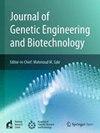Immunoinformatics-driven design of a multi-epitope vaccine against nipah virus: A promising approach for global health protection
IF 2.8
Q3 Biochemistry, Genetics and Molecular Biology
Journal of Genetic Engineering and Biotechnology
Pub Date : 2025-03-27
DOI:10.1016/j.jgeb.2025.100482
引用次数: 0
Abstract
This study focuses on developing a multi-epitope vaccine against the highly pathogenic Nipah virus using immunoinformatics. It aims to design a vaccine targeting the viral nucleoprotein to elicit robust immune responses. The approach integrates epitope prediction, vaccine construction, and validation through computational tools to address the lack of effective vaccines and mitigate global health threats posed by Nipah virus outbreaks. Immunoinformatics approaches have been utilized for epitope prediction, focusing on B-cell and T-cell epitopes of the Nipah virus nucleoprotein. The multi-epitope vaccine was constructed using linkers and adjuvants to enhance immunogenicity. Structural refinement, molecular docking with human ephrin B2 receptor, and immune simulations were performed to validate the vaccine’s stability, binding efficiency, and immune response potential. The designed multi-epitope vaccine exhibited high antigenicity (0.56), non-allergenicity, and non-toxicity. Docking analysis showed a strong binding affinity with the ephrin B2 receptor (binding energy: −920 kcal/mol). Immune simulations indicated significant immune responses with high IgG and IgM levels and memory B-cell activation. Population coverage analysis revealed a global coverage of 88.3 %, supporting its potential for broad immunization. The designed vaccine against the Nipah virus demonstrates promising antigenicity, stability, and strong binding with the ephrin B2 receptor. With global population coverage and a robust immune response, it holds potential for clinical development. Further experimental validation and in vitro studies are recommended to confirm its efficacy as a viable vaccine candidate for the Nipah virus.
免疫信息学驱动的尼帕病毒多表位疫苗设计:一种有希望的全球健康保护方法
本研究的重点是利用免疫信息学开发一种针对高致病性尼帕病毒的多表位疫苗。它旨在设计一种针对病毒核蛋白的疫苗,以引发强大的免疫反应。该方法通过计算工具整合了表位预测、疫苗构建和验证,以解决缺乏有效疫苗的问题,并减轻尼帕病毒暴发造成的全球健康威胁。免疫信息学方法已被用于预测尼帕病毒核蛋白的表位,重点是b细胞和t细胞表位。采用连接剂和佐剂构建多表位疫苗,增强免疫原性。通过结构优化、与人ephrin B2受体的分子对接和免疫模拟来验证疫苗的稳定性、结合效率和免疫反应潜力。所设计的多表位疫苗具有高抗原性(0.56)、无致敏性和无毒性。对接分析表明,该蛋白与ephrin B2受体具有较强的结合亲和力(结合能:−920 kcal/mol)。免疫模拟显示免疫应答显著,IgG和IgM水平高,记忆b细胞活化。人口覆盖率分析显示,全球覆盖率为88.3%,支持其广泛免疫的潜力。所设计的尼帕病毒疫苗具有良好的抗原性、稳定性和与ephrin B2受体的强结合性。由于全球人口覆盖和强大的免疫反应,它具有临床开发的潜力。建议进一步进行实验验证和体外研究,以确认其作为尼帕病毒可行候选疫苗的有效性。
本文章由计算机程序翻译,如有差异,请以英文原文为准。
求助全文
约1分钟内获得全文
求助全文
来源期刊

Journal of Genetic Engineering and Biotechnology
Biochemistry, Genetics and Molecular Biology-Biotechnology
CiteScore
5.70
自引率
5.70%
发文量
159
审稿时长
16 weeks
期刊介绍:
Journal of genetic engineering and biotechnology is devoted to rapid publication of full-length research papers that leads to significant contribution in advancing knowledge in genetic engineering and biotechnology and provide novel perspectives in this research area. JGEB includes all major themes related to genetic engineering and recombinant DNA. The area of interest of JGEB includes but not restricted to: •Plant genetics •Animal genetics •Bacterial enzymes •Agricultural Biotechnology, •Biochemistry, •Biophysics, •Bioinformatics, •Environmental Biotechnology, •Industrial Biotechnology, •Microbial biotechnology, •Medical Biotechnology, •Bioenergy, Biosafety, •Biosecurity, •Bioethics, •GMOS, •Genomic, •Proteomic JGEB accepts
 求助内容:
求助内容: 应助结果提醒方式:
应助结果提醒方式:


